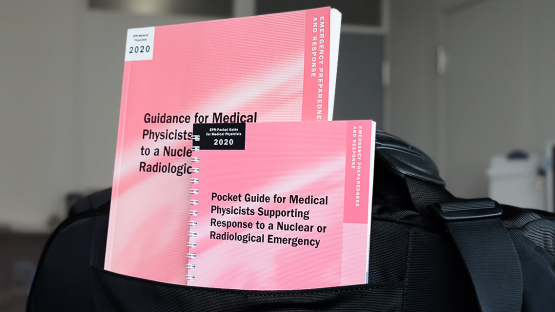Radiation emergencies can occur anywhere, at any time and protecting the health and safety of the affected individuals is the first priority. How can people, including medical personnel, be assured that they are protected when there are no radiation experts on site?
Medical physicists, uniquely qualified to provide emergency support are usually not trained in emergency preparedness and response (EPR). A recently issued IAEA publication, the Guidance for Medical Physicists Responding to a Nuclear or Radiological Emergency, provides specific details to help close that gap and enable clinically qualified medical physicists to effectively support first responders during a nuclear or radiological accident. The publication has also been condensed into an accompanying pocket guide for swift information.
“There have been other emergency preparedness and response guidance for medical personnel, like the Generic Procedures for Medical Response During a Nuclear or Radiological Emergency (EPR-medical physicists), but no precise guidance for medical physicists was available prior to this guide,” said Mai Fukahori, a medical physicist and emergency preparedness officer at the IAEA’s Incident and Emergency Centre. “The medical physicists can play a vital role in the response to radiation emergencies. They need to be aware of their role in such emergencies as well as the command chain governing the response to a nuclear or radiological emergency.”
Medical physicists are health professionals with specialist academic education and clinical training on the concepts and techniques of applying physics in medicine. They are thus competent to ensure that patients are subjected to medical radiation techniques are screened and treated safely and effectively with these radiation technologies. They have extensive knowledge of radiation dosimetry, dose measurement and reconstruction, and radiation protection. They are also experienced in collaborating with other medical professionals across many areas of expertise. Medical physicists’ specific set of skills, with effective education and training, enables them to serve as an invaluable asset for Member States’ radiation emergency response systems.
"A key element in this publication is the syllabus for training medical physicists for nuclear and radiological emergencies,” Fukahori highlighted. The thirteen training modules in the guide are designed to substantially upgrade the knowledge of medical physicists in EPR — from an introduction to nuclear and radiological emergencies, to training fellow medical physicists and other health professionals. Each module of the syllabus is supplemented by reading lists for further reference. Member States can use this syllabus when conducting training. This syllabus also serves as a basis for academic bodies in Member States to include training for radiation emergencies in their medical physics curriculum.
Medical physicists can play a vital role in the response to radiation emergencies.





